Page 213 of 258
200
Engine compartment overview
1. Engine coolant reservoir
2. Fuse blocks
3. Brake fluid reservoir
4. Engine oil filler cap
5. Inverter reservoir tank
6. Windshield washer fluid tank
7. Radiator and condenser
8. Engine oil level dipstick
9. Auxiliary battery
81p001f
Page 216 of 258
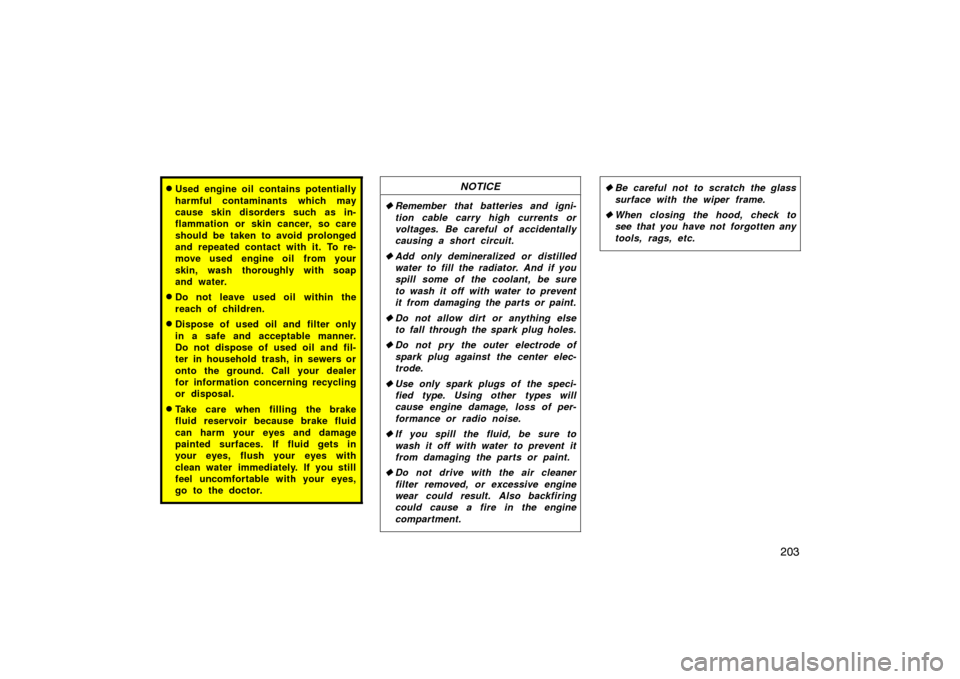
203
�Used engine oil contains potentially
harmful contaminants which may
cause skin disorders such as in-
flammation or skin cancer, so care
should be taken to avoid prolonged
and repeated contact with it. To re-
move used engine oil from your
skin, wash thoroughly with soap
and water.
�Do not leave used oil within the
reach of children.
�Dispose of used oil and filter only
in a safe and acceptable manner.
Do not dispose of used oil and fil-
ter in household trash, in sewers or
onto the ground. Call your dealer
for information concerning recycling
or disposal.
�Take care when filling the brake
fluid reservoir because brake fluid
can harm your eyes and damage
painted surfaces. If fluid gets in
your eyes, flush your eyes with
clean water immediately. If you still
feel uncomfortable with your eyes,
go to the doctor.
NOTICE
�Remember that batteries and igni-
tion cable carry high currents or
voltages. Be careful of accidentally
causing a short circuit.
� Add only demineralized or distilled
water to fill the radiator. And if you
spill some of the coolant, be sure
to wash it off with water to prevent
it from damaging the parts or paint.
� Do not allow dirt or anything else
to fall through the spark plug holes.
� Do not pry the outer electrode of
spark plug against the center elec-
trode.
� Use only spark plugs of the speci-
fied type. Using other types will
cause engine damage, loss of per-
formance or radio noise.
� If you spill the fluid, be sure to
wash it off with water to prevent it
from damaging the parts or paint.
� Do not drive with the air cleaner
filter removed, or excessive engine
wear could result. Also backfiring
could cause a fire in the engine
compartment.
�Be careful not to scratch the glass
surface with the wiper frame.
� When closing the hood, check to
see that you have not forgotten any
tools, rags, etc.
Page 217 of 258

204
Positioning the jack
81p008b
Front
81p009b
Rear
When jacking up your vehicle with the
jack, position the jack correctly as
shown in the illustrations.
CAUTION
When jacking, be sure to observe the
following to reduce the possibility of
personal injury:
�Follow jacking instructions.
�Do not put any part of your body
under the vehicle supported by the
jack. Personal injury may occur.
�Do not start or run the engine while
your vehicle is supported by the
jack.
�Stop the vehicle on a level firm
ground, firmly set the parking brake
and put the transmission in “P”.
�Make sure to set the jack properly
in the jack point. Raising the ve-
hicle with jack improperly posi-
tioned will damage the vehicle or
may allow the vehicle to fall off the
jack and cause personal injury.
�Never get under the vehicle when
the vehicle is supported by the jack
alone.
�Do not raise the vehicle with some-
one in the vehicle.
�When raising the vehicle, do not
put an object on or under the jack.
NOTICE
Make sure to place the jack correctly,
or your vehicle may be damaged.
Page 218 of 258

205
Parts and tools
Here is a list of parts and tools you will
need on performing do−it−yourself mainte-
nance. Remember all Toyota parts are de-
signed in metric sizes, so your tools must
be metric.
CHECKING THE ENGINE OIL LEVEL
Parts (if level is low):
�Engine oil API grade SJ “Energy −Con-
serving”, SL “Energy −Conserving” or IL-
SAC multigrade having viscosity proper
for your climate
Tools:
�Rag or paper towel
�Funnel (only for adding oil)
CHECKING THE COOLANT LEVEL
Parts (if level is low):
�”TOYOTA Long Life Coolant” or equiva-
lent
See page 210 in Section 8 −2 for de-
tails about coolant type selection.
�Demineralized or distilled water
Tools:
�Funnel (only for adding coolant) CHECKING BRAKE FLUID
Parts (if level is low):
�SAE J1703 or FMVSS No.116 DOT 3
brake fluid
Tools:
�Rag or paper towel
�Funnel (only for adding fluid)
CHECKING AUXILIARY BATTERY CON-
DITION
Tools:
�Warm water
�Baking soda
�Grease
�Conventional wrench (for terminal
clamp bolts)
CHECKING AND REPLACING FUSES
Parts (if replacement is necessary):
�Fuse with same amperage rating as
original
ADDING WASHER FLUID
Parts:
�Water
�Washer fluid containing antifreeze (for
winter use) Tools:
�Funnel
REPLACING LIGHT BULBS
Parts:
�Bulb with same number and wattage
rating as original (See charts in ”Re-
placing light bulbs–” on page 225 in
Section 8 −3.)
Tools:
�Screwdriver
Page 220 of 258
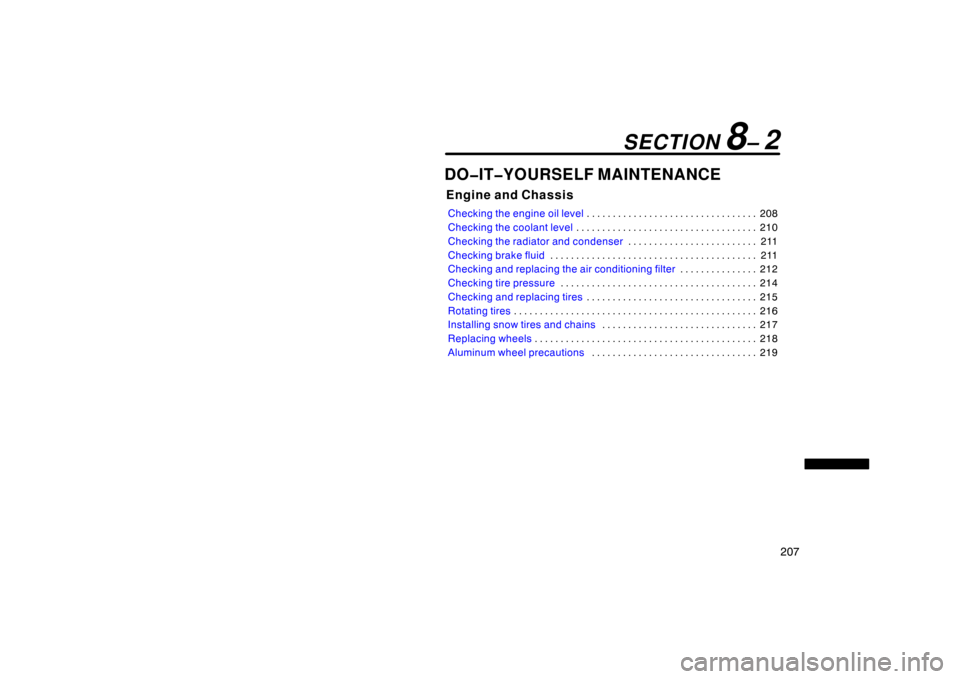
207
DO�IT�YOURSELF MAINTENANCE
Engine and Chassis
Checking the engine oil level208
. . . . . . . . . . . . . . . . . . . . . . . . . . . . . . . . .
Checking the coolant level 210
. . . . . . . . . . . . . . . . . . . . . . . . . . . . . . . . . . .
Checking the radiator and condenser 211
. . . . . . . . . . . . . . . . . . . . . . . . .
Checking brake fluid 211
. . . . . . . . . . . . . . . . . . . . . . . . . . . . . . . . . . . . \
. . . .
Checking and replacing the air conditioning filter 212
. . . . . . . . . . . . . . .
Checking tire pressure 214
. . . . . . . . . . . . . . . . . . . . . . . . . . . . . . . . . . . . \
. .
Checking and replacing tires 215
. . . . . . . . . . . . . . . . . . . . . . . . . . . . . . . . .
Rotating tires 216
. . . . . . . . . . . . . . . . . . . . . . . . . . . . . . . . . . . . \
. . . . . . . . . . .
Installing snow tires and chains 217
. . . . . . . . . . . . . . . . . . . . . . . . . . . . . .
Replacing wheels 218
. . . . . . . . . . . . . . . . . . . . . . . . . . . . . . . . . . . . \
. . . . . . .
Aluminum wheel precautions 219
. . . . . . . . . . . . . . . . . . . . . . . . . . . . . . . .
SECTION 8– 2
Page 224 of 258
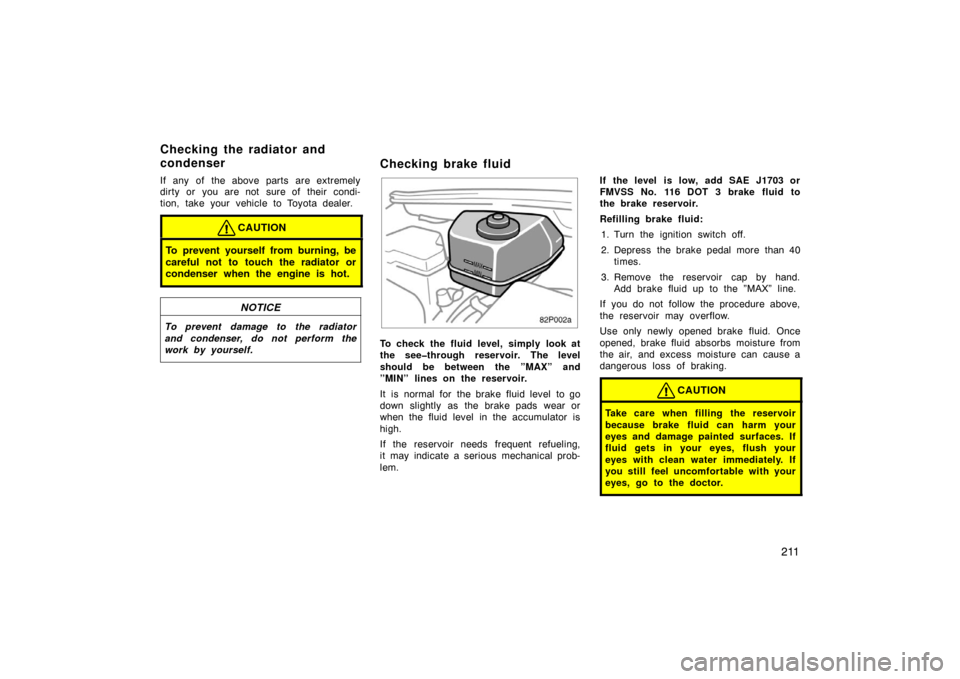
211
If any of the above parts are extremely
dirty or you are not sure of their condi-
tion, take your vehicle to Toyota dealer.
CAUTION
To prevent yourself from burning, be
careful not to touch the radiator or
condenser when the engine is hot.
NOTICE
To prevent damage to the radiator
and condenser, do not perform the
work by yourself.
Checking brake fluid
82p002a
To check the fluid level, simply look at
the see�through reservoir. The level
should be between the ”MAX” and
”MIN” lines on the reservoir.
It is normal for the brake fluid level to go
down slightly as the brake pads wear or
when the fluid level in the accumulator is
high.
If the reservoir needs frequent refueling,
it may indicate a serious mechanical prob-
lem.If the level is low, add SAE J1703 or
FMVSS No. 116 DOT 3 brake fluid to
the brake reservoir.
Refilling brake fluid:
1. Turn the ignition switch off.
2. Depress the brake pedal more than 40 times.
3. Remove the reservoir cap by hand. Add brake fluid up to the ”MAX” line.
If you do not follow the procedure above,
the reservoir may overflow.
Use only newly opened brake fluid. Once
opened, brake fluid absorbs moisture from
the air, and excess moisture can cause a
dangerous loss of braking.
CAUTION
Take care when filling the r eservoir
because brake fluid can harm your
eyes and damage painted surfaces. If
fluid gets in your eyes, flush your
eyes with clean water immediately. If
you still feel uncomfortable with your
eyes, go to the doctor.
Checking the radiator and
condenser
Page 231 of 258
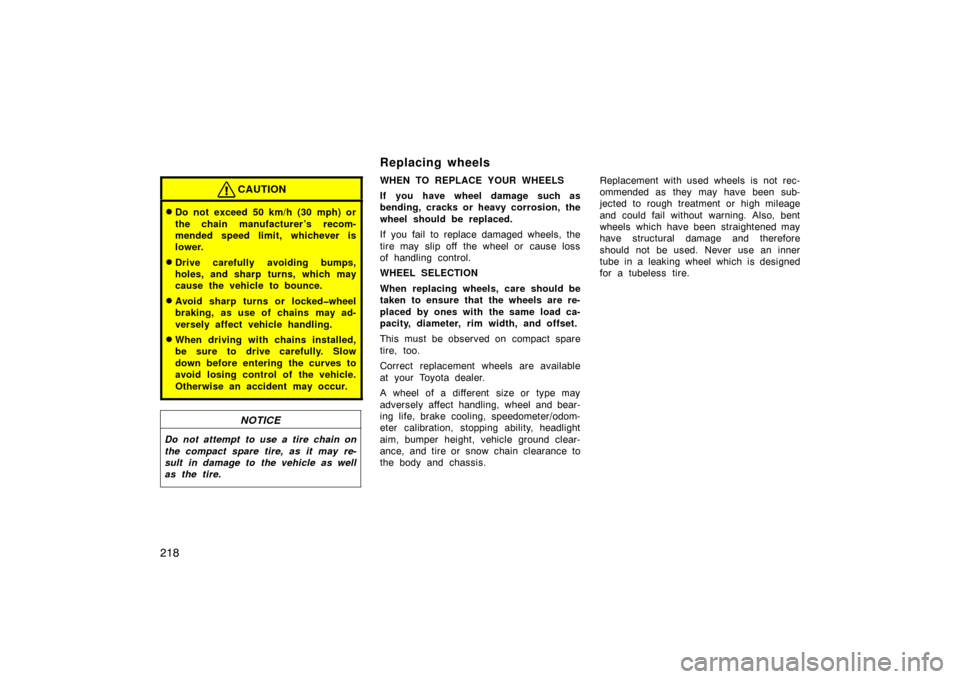
218
CAUTION
�Do not exceed 50 km/h (30 mph) or
the chain manufacturer ’s recom-
mended speed limit, whichever is
lower.
�Drive carefully avoiding bumps,
holes, and sharp turns, which may
cause the vehicle to bounce.
�Avoid sharp turns or locked�wheel
braking, as use of chains may ad-
versely affect vehicle handling.
�When driving with chains installed,
be sure to drive carefully. Slow
down before entering the curves to
avoid losing control of the vehicle.
Otherwise an accident may occur.
NOTICE
Do not attempt to use a tire chain on
the compact spare tire, as it may re-
sult in damage to the vehicle as well
as the tire.
WHEN TO REPLACE YOUR WHEELS
If you have wheel damage such as
bending, cracks or heavy corrosion, the
wheel should be replaced.
If you fail to replace damaged wheels, the
tire may slip off the wheel or cause loss
of handling control.
WHEEL SELECTION
When replacing wheels, care should be
taken to ensure that the wheels are re-
placed by ones with the same load ca-
pacity, diameter, rim width, and offset.
This must be observed on compact spare
tire, too.
Correct replacement wheels are available
at your Toyota dealer.
A wheel of a different size or type may
adversely affect handling, wheel and bear-
ing life, brake cooling, speedometer/odom-
eter calibration, stopping ability, headlight
aim, bumper height, vehicle ground clear-
ance, and tire or snow chain clearance to
the body and chassis.Replacement with used wheels is not rec-
ommended as they may have been sub-
jected to rough treatment or high mileage
and could fail without warning. Also, bent
wheels which have been straightened may
have structural damage and therefore
should not be used. Never use an inner
tube in a leaking wheel which is designed
for a tubeless tire.
Replacing wheels
Page 250 of 258
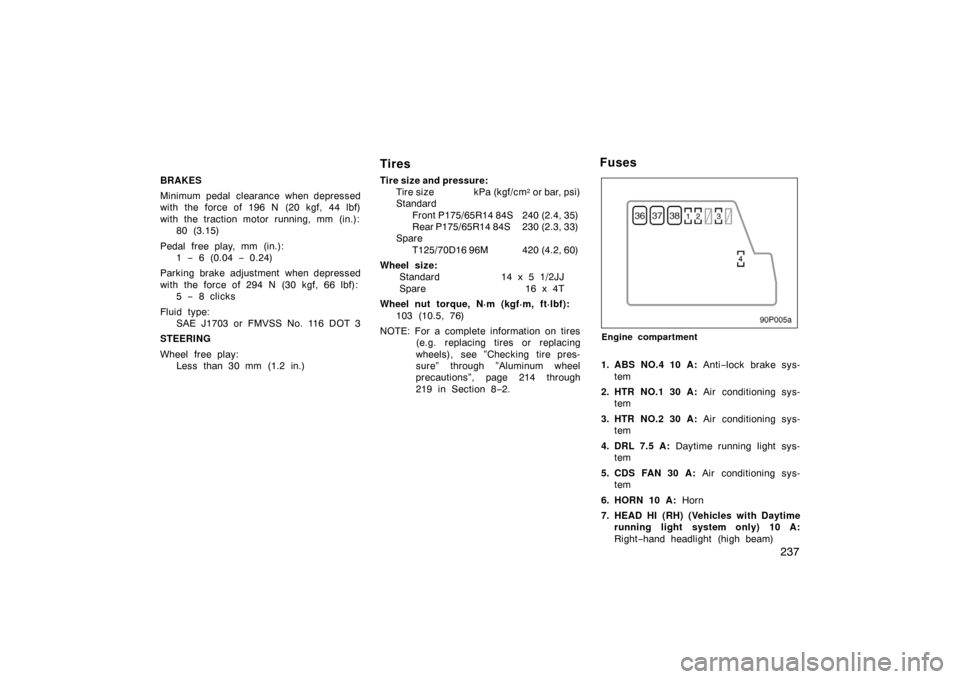
237
BRAKES
Minimum pedal clearance when depressed
with the force of 196 N (20 kgf, 44 lbf)
with the traction motor running, mm (in.):80 (3.15)
Pedal free play, mm (in.): 1 − 6 (0.04 − 0.24)
Parking brake adjustment when depressed
with the force of 294 N (30 kgf, 66 lbf): 5 − 8 clicks
Fluid type: SAE J1703 or FMVSS No. 116 DOT 3
STEERING
Wheel free play: Less than 30 mm (1.2 in.)
Tires
Tire size and pressure:Tire size kPa (kgf/cm2 or bar, psi)
Standard
Front P175/65R14 84S 240 (2.4, 35)
Rear
P175/65R14 84S 230 (2.3, 33)
Spare
T125/70D16 96M 420 (4.2, 60)
Wheel size: Standard 14 x 5 1/2JJ
Spare 16 x 4T
Wheel nut torque, N·m (kgf·m, ft·lbf): 103 (10.5, 76)
NOTE: For a complete information on tires (e.g. replacing tires or replacing
wheels), see ”Checking tire pres-
sure” through ”Aluminum wheel
precautions”, page 214 through
219 in Section 8 −2.
90p005a
Engine compartment
1. ABS NO.4 10 A: Anti−lock brake sys-
tem
2. HTR NO.1 30 A: Air conditioning sys-
tem
3. HTR NO.2 30 A: Air conditioning sys-
tem
4. DRL 7.5 A: Daytime running light sys-
tem
5. CDS FAN 30 A: Air conditioning sys-
tem
6. HORN 10 A: Horn
7. HEAD HI (RH) (Vehicles with Daytime running light system only) 10 A:
Right −hand headlight (high beam)
Fuses